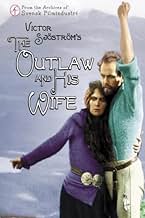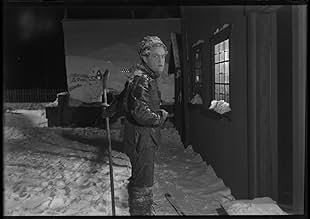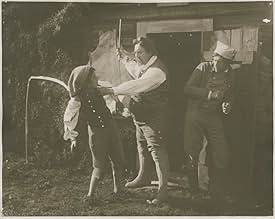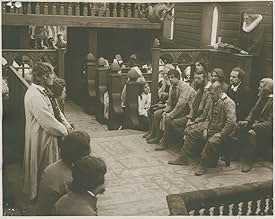IMDb-BEWERTUNG
7,1/10
2230
IHRE BEWERTUNG
Füge eine Handlung in deiner Sprache hinzuEjvind and his family are in need of food. So Ejvind seeks help from the rich priest next door. He refuses to help. Ejvind then steals a sheep from the priest, he is caught. But he escapes f... Alles lesenEjvind and his family are in need of food. So Ejvind seeks help from the rich priest next door. He refuses to help. Ejvind then steals a sheep from the priest, he is caught. But he escapes from prison, and becomes an outlaw.Ejvind and his family are in need of food. So Ejvind seeks help from the rich priest next door. He refuses to help. Ejvind then steals a sheep from the priest, he is caught. But he escapes from prison, and becomes an outlaw.
- Regie
- Drehbuch
- Hauptbesetzung
Walerie Alexandrow-Höök
- Berg-Ejvinds och Hallas dotter Tota
- (as Walerie Alexandrow)
Empfohlene Bewertungen
7Foxx
This film was Victor Sjöströms international break-through and it's not hard to understand why. It wasn't the first time Sjöström had used the wild and unpredictable nature as an illustrator or commentator, but this time the scenery and the acting was in the same level of quality. A wonderful piece of art.
I have waited for years to see this film and finally caught it on Youtube - in excellent condition. It was definitely worth the wait! The film was made in 1918, a time when most cinema consisted of small segments of celluloid patched together with the standard melodramatic or comedic situations, clumsily filmed indoors on make-shift sets. This is absolutely nothing of the kind although it took Hollywood what seemed an eternity to figure out that a movie could, indeed, be shot out in the open with great success. Several reviewers have mentioned some sort of connection with early Westerns made by directors of little artistic talent and less scope. Actually, this film has nothing whatsoever to deal with standard plots with famous actors. The plot is extremely simple, as it should be in this case, and all - virtually all - of the over-the-board overacting and the theatrical motions and over-emotions suppressed, with natural gestures replacing them in natural settings...and what beautiful settings they are! No, there aren't any tied-together happy ends around and little to titillate the audience, villains with mustaches or any of the standard American clichés here. The film is Scandinavian, filmed and acted by Scandinavians, shot in North Sweden far, far away from the ole corral. I don't know how well the director, Victor Sjostrom, was acquainted with American cinema at the time - there wasn't really much of anything of much value going except from Griffith and one or two others, but the film borrows nothing and invents everything for its own uses. The cinema up there created a universe of its own, albeit a harsh one. Bergman would follow fifty years later. This was a welcome hour or so spent in the company of people who made some astoundingly good films and this is certainly one of them.
Curtis Stotlar
Curtis Stotlar
It's hard to imagine, but only a few years before this film debuted, most films were only a few minutes long. And, full-length films really were a pretty new thing. So, to see a long, complex and cinematic film like "You and I" shows just how far the industry had grown. Victor Sjöström plays a man who is on the run from the law. Years earlier, he'd been sent to prison for stealing a sheep to feed his family and he'd eventually broken out of a tiny make-shift prison in Iceland. The film picks up when he's on the run in the interior of the country--looking for work and hoping no one recognizes him. In the process, a woman takes him in to work on her farm and eventually the two fall in love....at about the time the law shows up to claim him. The two run off together and live in the inhospitable wilds for the next 17 years (yikes). Exactly what happens is something you'll just need to see for yourself--but it does have some nice surprises.
The film is well worth seeing mostly for the nice acting and cinematography. Interestingly, in addition to starring in the film, Sjöström directed and co-wrote this film--and the look of the film can clearly be attributed to him. I also appreciate how he was able to recreate the look of Iceland nicely by apparently filming in the middle of no where AND in pretty inhospitable weather. A very good film--and it has some nice things to say about crime and punishment.
The film is well worth seeing mostly for the nice acting and cinematography. Interestingly, in addition to starring in the film, Sjöström directed and co-wrote this film--and the look of the film can clearly be attributed to him. I also appreciate how he was able to recreate the look of Iceland nicely by apparently filming in the middle of no where AND in pretty inhospitable weather. A very good film--and it has some nice things to say about crime and punishment.
The stunning Lappland scenery and seeing Victor Sjöström made this one enjoyable for me, despite a little creakiness in the early going. The setup, actually told in a flashback, reminded me of Les Miserables in that a man (Sjöström) turns to theft out of poverty, but instead of the local parson forgiving him as in that work, he jails him instead. Perhaps there is commentary on the church in this, and the need to show a little kindness to the less fortunate, since everything that happens to this decent guy stems from that incident. Anyway, he breaks out of jail, finds work on a farm, and falls in love with the owner (Edith Erastoff), but his past is never far behind.
The film gets good and the drama increases when the pair flee to the mountains, where they live a rugged life and have a baby girl. There are several moments at a cliff that are quite tense, and one that seems hard to fathom (I mean, really hard to fathom). Maybe the film shows us what desperation will drive people to, aside from the theft - jealousy, turning on one another, and acts you'd never think possible. Set against the grand scenery of those timeless mountains and waterfalls though, the human struggle seems especially small, even when it is gripping.
The pace is quite good at 73 minutes - intertitles are kept to a minimum, and the story, while simple, moves along nicely. At times it feels like the psychological drama is as claustrophobic as the wilderness is wide open. The film is obviously a bit stiff to modern eyes, but it seems clear that for 1918, it was ahead of its time.
The film gets good and the drama increases when the pair flee to the mountains, where they live a rugged life and have a baby girl. There are several moments at a cliff that are quite tense, and one that seems hard to fathom (I mean, really hard to fathom). Maybe the film shows us what desperation will drive people to, aside from the theft - jealousy, turning on one another, and acts you'd never think possible. Set against the grand scenery of those timeless mountains and waterfalls though, the human struggle seems especially small, even when it is gripping.
The pace is quite good at 73 minutes - intertitles are kept to a minimum, and the story, while simple, moves along nicely. At times it feels like the psychological drama is as claustrophobic as the wilderness is wide open. The film is obviously a bit stiff to modern eyes, but it seems clear that for 1918, it was ahead of its time.
Natural surroundings heighten a movie director's ability to examine his characters' identities. The first film in cinema to introduce soaring landscapes and weather elements for the purpose of exploring the actors' interior personalities is Swedish director Victor Sjostrom's January 1918 "The Outlaw and His Wife."
Based on the true story of a mid-1700 criminal escaping incarceration with his wife into the mountains of Iceland, "The Outlaw and His Wife" uses the stunning scenery of northern Sweden to reflect nature's impact on human behavior, especially displayed in the second half of the movie.
Sjostrom and Edith Erastoff appeared in the director's earlier "The Man There Was," and began a relationship despite Erastoff marriage status. In fact, Edith was pregnant with Sjostrom's child when filming "The Outlaw and His Wife." She delivered a girl, Guje Lagerwall, who lived to be 100, soon after the January premier. Sjostrom and Erastoff eventually married in 1922 after she secured a divorce from her first husband.
Sjostrom worked well with cinematographer Julius Jaenzon, who lends a surreal tone to this highly visual film. He uses the sun frequently to backlight the actors, and often overexposes the film to portray them in a fairytale-like glow. Jaenzon also silhouettes his on-camera personalities against huge backdrops to emphasize how puny people and their problems are in relation to the overall scheme of God's great work in presenting earth's majesty.
Besides man's co-existing with a sometimes turbulent nature, Sjostrom shows the psychological mechanics within a human relationship, especially reflected memorably in the sequence where Erastoff throws the couple's baby over the cliff. Such stress in hiding from the law in an unforgiving environment casts a light on the breaking point of the human condition in such circumstances.
Today's directors such as Terrance Malick, known for his photographic expertise, studied "The Outlaw and His Wife" for its natural elements incorporated into their characters' behavior and plot motivations. Sjostrom's film played a huge influence on later visually-stunning motion pictures using nature's varied landscapes.
Based on the true story of a mid-1700 criminal escaping incarceration with his wife into the mountains of Iceland, "The Outlaw and His Wife" uses the stunning scenery of northern Sweden to reflect nature's impact on human behavior, especially displayed in the second half of the movie.
Sjostrom and Edith Erastoff appeared in the director's earlier "The Man There Was," and began a relationship despite Erastoff marriage status. In fact, Edith was pregnant with Sjostrom's child when filming "The Outlaw and His Wife." She delivered a girl, Guje Lagerwall, who lived to be 100, soon after the January premier. Sjostrom and Erastoff eventually married in 1922 after she secured a divorce from her first husband.
Sjostrom worked well with cinematographer Julius Jaenzon, who lends a surreal tone to this highly visual film. He uses the sun frequently to backlight the actors, and often overexposes the film to portray them in a fairytale-like glow. Jaenzon also silhouettes his on-camera personalities against huge backdrops to emphasize how puny people and their problems are in relation to the overall scheme of God's great work in presenting earth's majesty.
Besides man's co-existing with a sometimes turbulent nature, Sjostrom shows the psychological mechanics within a human relationship, especially reflected memorably in the sequence where Erastoff throws the couple's baby over the cliff. Such stress in hiding from the law in an unforgiving environment casts a light on the breaking point of the human condition in such circumstances.
Today's directors such as Terrance Malick, known for his photographic expertise, studied "The Outlaw and His Wife" for its natural elements incorporated into their characters' behavior and plot motivations. Sjostrom's film played a huge influence on later visually-stunning motion pictures using nature's varied landscapes.
Wusstest du schon
- WissenswertesBased on the story of Eyvindur of the Mountains (1714-1783), an outlaw in Iceland who fled into the mountains with his wife around 1760 and remained there for twenty years.
- Alternative VersionenTurner Classic Movies has shown on TV a restored version copyrighted in 1968 by Svenska Filminstitutet (The Swedish Film Instute). The restoration credits are in Swedish, but some of the original cast and crew credits are in English. All intertitles are in English and the film runs 73 minutes.
- VerbindungenFeatured in Victor Sjöström - ett porträtt av Gösta Werner (1981)
- SoundtracksKung Kristian II, op. 27
Composed by Jean Sibelius (1898)
Top-Auswahl
Melde dich zum Bewerten an und greife auf die Watchlist für personalisierte Empfehlungen zu.
- How long is The Outlaw and His Wife?Powered by Alexa
Details
- Erscheinungsdatum
- Herkunftsland
- Offizieller Standort
- Sprache
- Auch bekannt als
- Berg-Eyvind und sein Weib
- Drehorte
- Nuolja, Abisko, Schweden(mountain scenery)
- Produktionsfirma
- Weitere beteiligte Unternehmen bei IMDbPro anzeigen
Box Office
- Budget
- 100.000 SEK (geschätzt)
- Laufzeit1 Stunde 12 Minuten
- Sound-Mix
- Seitenverhältnis
- 1.33 : 1
Zu dieser Seite beitragen
Bearbeitung vorschlagen oder fehlenden Inhalt hinzufügen

Oberste Lücke
By what name was Berg-Ejvind und seine Frau (1918) officially released in Canada in English?
Antwort





























